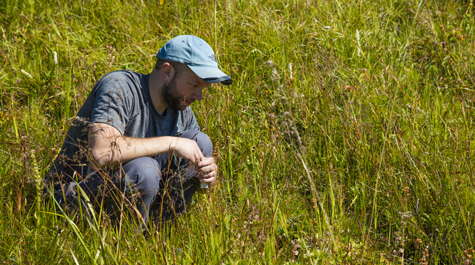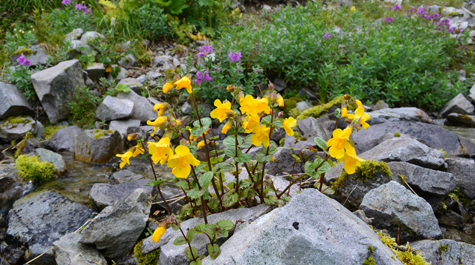In 'Science': Wildflowers combat climate change with diversity
In 1859, when Charles Darwin first articulated the theory of evolution, he speculated that a process of natural selection led species to adapt to their environments over time. He believed traits that helped an organism survive were passed down to offspring, who would pass those traits on to more offspring, eventually leading to the diversity of life we see today.
There was only one problem, Darwin didn’t actually understand how natural selection worked. It would take decades before scientists would discover genetics and the outlines of how traits are passed down— with Watson and Crick famously revealing DNA’s double helix shape in 1953.
For Josh Puzey, assistant professor of biology at William & Mary, there was a missing step in the trajectory from Darwin’s theory to mapping genomes. Puzey wanted to explain why there is such variation within species. If natural selection is as powerful as Darwin predicted, why aren’t individuals within a species all indistinguishable and equally fit?
“A simple, though perhaps a slightly naïve expectation, is that there should be no variation, because natural selection has pushed species towards a single optimum,” Puzey said. “So the question is: how does genetic variation persist in the face of natural selection?”
It’s a question Puzey is one step closer to solving. A paper he co-authored, “Selective trade-offs maintain alleles underpinning complex trait variation in plants,” was published today in the journal Science. The study finds a crucial link between natural selection and genetic variation. Puzey’s co-authors include Ashley Troth, Rebecca Kim, John Willis and John Kelly. Their research was funded by the National Institutes of Health and the National Science Foundation.
Puzey says the study is a breakthrough as one of the first to link phenotype (physical traits) and fitness (ability to reproduce and leave offspring) to genotype (traits coded into an individual’s DNA). To understand the difference between phenotype and genotype, think of the flamingo. A flamingo turns pink when it eats a certain kind of shrimp.
The shrimp diet changes the flamingo’s phenotype, its color, but it’s not directly affecting the flamingo’s genotype. Phenotype can change quickly as a direct result of environmental shifts. Genotype change is generational, through passing genes to offspring.
“We think about evolution and natural selection as always trying to find a more fit phenotype,” Puzey said. “When you have thousands of wildflowers on the side of a mountain, if evolution has been acting for generations, you’d predict they would all have the same phenotype. But they don’t, so we conducted a kind of a brute force study to tackle this question.”
Puzey was part of a team of scientists from four American research institutions who collected and analyzed seeds from 187 different seep monkey wildflowers (Mimulus guttatus) growing in the Iron Mountain region of Oregon.
Using the seeds, the researchers were able to sequence the genome of each individual flower. Then they returned to Oregon and planted the sequenced seeds on the same mountain where they were originally collected.
The team monitored each of the seedlings over the course of two years, measuring their fitness along the way. They recorded how many seeds each one produced, how well each flowered, if the flower reached reproductive maturity.
“Using those individuals, we were able to connect the genotype to the phenotype,” Puzey said. “As the flowers grew, we knew what was happening with the genes underneath and how those genes connected to the phenotype. That was the real novel part of this study.”
The team was able to identify specific regions in the genome that control flowering time and flower size. They found that the same region controls both traits. Late-blooming flowers produced bigger flowers than early-bloomers.
The researchers found traits that appeared as part of the phenotype — the way each individual looked — were physically connected to the genotype, Puzey explained. Simply put, the flowers had evolved over time to maintain genetic variation in flower size, because it helped them survive.
Natural selection chooses phenotypes that are most fit to the native environment, but if that environment is always fluctuating, then selection may have acted to maintain genetic variation in order to deal with whatever the environment throws at it.
“We found that fitness is dependent on the environment they are growing in during that exact year,” Puzey said.
In one year, there was a short period of water availability as snow melted. The short, wet period was followed by the rapid onset of summer. The seep monkey flowers that were smaller and flowered sooner were more likely to reach productive maturity under those conditions, Puzey explained.
The following year, spring rains lasted longer and the summer drought arrived much later in the season. In that year, the researchers found the individuals that grew larger and flowered later were fitter.
“Sometimes small flowers are favored and sometimes big flowers are favored, depending on how wet it is,” Puzey said. “So we have one answer to the question ‘how is genetic variation maintained in the face of natural selection?’ Interannual variation selects alternate genetic makeups and alternate phenotypes in opposite years, allowing variation to persist.”
Since the genetic makeup of seep monkey flowers is so well-adapted to interannual climate fluctuations, the researchers wondered whether the genetic variations maintained in the wildflower could be beneficial for adapting to climate change.
“It’s a more applied conservation question,” Puzey said. “Is there enough variation present in these natural populations to adapt rapidly to global climate change?”
The researchers believe there is. The climate fluctuations are so extreme in the Iron Mountain region that researchers believe the genetic diversity within the seep monkey population should allow for it to adapt to long-term climate change.
Puzey warns that good news for seep monkey flowers does not necessarily mean good news for other Iron Mountain wildlife. Changes in flowering time and flower size has a direct impact on pollinators such as foraging bees. Any changes in foraging patterns could affect other wildflowers and impact what species bloom at what time. Puzey stresses there is an entire ecosystem at stake.
“While this paints a promising picture for Mimulus in the face of climate change,” Puzey said, “there are many interactions not represented in our study. Some of them could completely fall apart as the climate warms.”

















